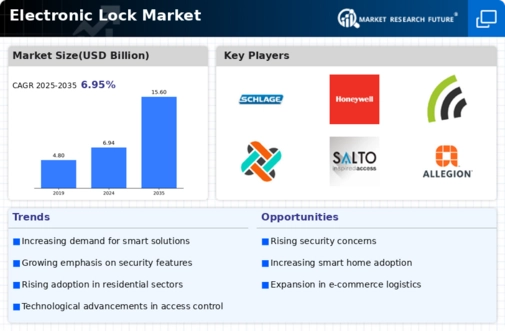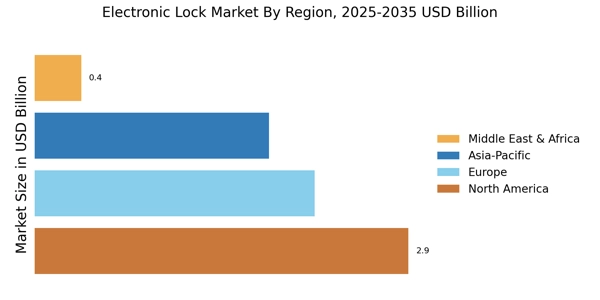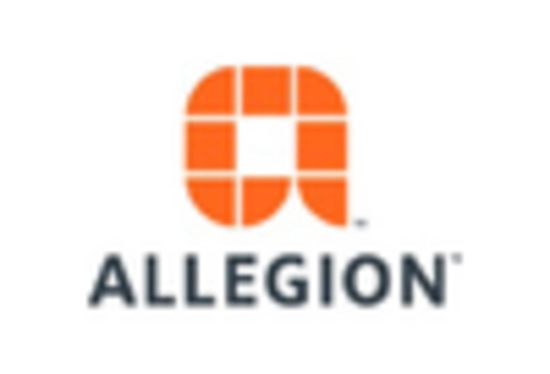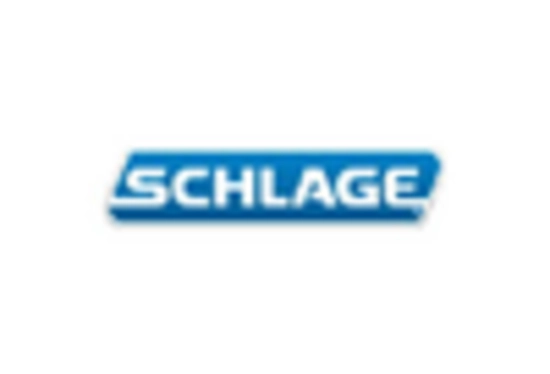Growth of the E-commerce Sector
The growth of the e-commerce sector significantly impacts the Electronic Lock Market. As online shopping continues to gain traction, the demand for secure delivery solutions has increased. Electronic locks are increasingly being utilized in smart lockers and delivery boxes, providing a secure method for package delivery. Market analysis indicates that the e-commerce sector is expected to grow at a rate of 12% annually, which in turn drives the need for innovative electronic locking solutions that ensure the safety of delivered goods. This trend presents a lucrative opportunity for manufacturers in the Electronic Lock Market to develop products tailored to the needs of e-commerce businesses and consumers seeking secure delivery options.
Increasing Focus on Home Security
The Electronic Lock Market is witnessing an increasing focus on home security, driven by rising concerns over burglary and property crime. As homeowners seek to protect their assets, the demand for advanced locking systems that offer superior security features is on the rise. Recent statistics indicate that homes equipped with electronic locks experience a 30% lower risk of break-ins compared to those with traditional locks. This heightened awareness of security has prompted manufacturers to innovate and offer products that incorporate features such as tamper alerts, remote locking, and integration with home security systems. As a result, the Electronic Lock Market is likely to expand as consumers prioritize safety and invest in reliable locking solutions.
Regulatory Compliance and Standards
Regulatory compliance and standards are becoming increasingly important in the Electronic Lock Market. Governments and regulatory bodies are establishing guidelines to ensure the safety and reliability of electronic locking systems. Compliance with these standards not only enhances consumer trust but also drives manufacturers to innovate and improve their products. For instance, locks that meet specific security certifications are more likely to be favored by consumers, leading to increased sales. As the market evolves, adherence to these regulations is expected to shape product development and influence purchasing decisions. Consequently, the Electronic Lock Market is likely to see a rise in demand for compliant products that meet stringent safety and security standards.
Rising Demand for Keyless Entry Solutions
The Electronic Lock Market experiences a notable surge in demand for keyless entry solutions. This trend is driven by the increasing preference for convenience and enhanced security among consumers. As urbanization continues to rise, more individuals seek efficient access control systems that eliminate the need for traditional keys. According to recent data, the keyless entry segment is projected to grow at a compound annual growth rate of approximately 15% over the next five years. This growth indicates a shift in consumer behavior towards adopting advanced locking mechanisms that offer both ease of use and improved security features. Consequently, manufacturers in the Electronic Lock Market are focusing on developing innovative keyless solutions that cater to the evolving needs of consumers.
Technological Advancements in Locking Mechanisms
Technological advancements play a pivotal role in shaping the Electronic Lock Market. Innovations such as biometric recognition, mobile app integration, and remote access capabilities are transforming traditional locking systems into sophisticated security solutions. The integration of artificial intelligence and machine learning into electronic locks enhances their functionality, allowing for real-time monitoring and alerts. Market data suggests that the adoption of smart locks, which utilize these technologies, is expected to increase significantly, with a projected market share growth of over 20% in the next few years. This trend indicates a strong consumer inclination towards adopting cutting-edge technology for enhanced security and convenience, thereby driving the overall growth of the Electronic Lock Market.


















Leave a Comment